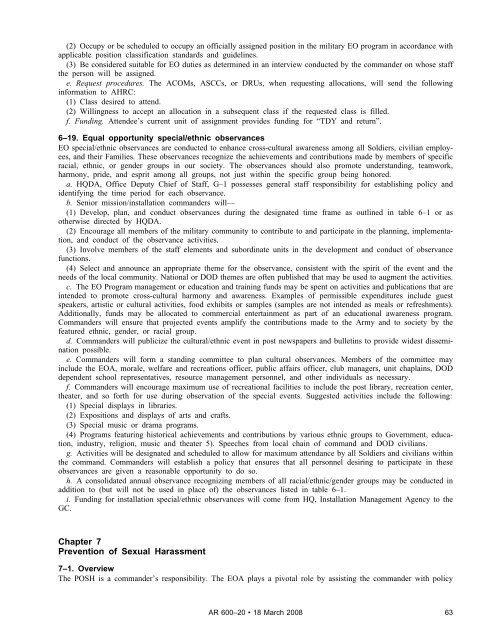AR 600-20, Army Command Policy - Army Publishing Directorate ...
AR 600-20, Army Command Policy - Army Publishing Directorate ...
AR 600-20, Army Command Policy - Army Publishing Directorate ...
You also want an ePaper? Increase the reach of your titles
YUMPU automatically turns print PDFs into web optimized ePapers that Google loves.
(2) Occupy or be scheduled to occupy an officially assigned position in the military EO program in accordance with<br />
applicable position classification standards and guidelines.<br />
(3) Be considered suitable for EO duties as determined in an interview conducted by the commander on whose staff<br />
the person will be assigned.<br />
e. Request procedures. The ACOMs, ASCCs, or DRUs, when requesting allocations, will send the following<br />
information to AHRC:<br />
(1) Class desired to attend.<br />
(2) Willingness to accept an allocation in a subsequent class if the requested class is filled.<br />
f. Funding. Attendee’s current unit of assignment provides funding for “TDY and return”.<br />
6–19. Equal opportunity special/ethnic observances<br />
EO special/ethnic observances are conducted to enhance cross-cultural awareness among all Soldiers, civilian employees,<br />
and their Families. These observances recognize the achievements and contributions made by members of specific<br />
racial, ethnic, or gender groups in our society. The observances should also promote understanding, teamwork,<br />
harmony, pride, and esprit among all groups, not just within the specific group being honored.<br />
a. HQDA, Office Deputy Chief of Staff, G–1 possesses general staff responsibility for establishing policy and<br />
identifying the time period for each observance.<br />
b. Senior mission/installation commanders will—<br />
(1) Develop, plan, and conduct observances during the designated time frame as outlined in table 6–1 or as<br />
otherwise directed by HQDA.<br />
(2) Encourage all members of the military community to contribute to and participate in the planning, implementation,<br />
and conduct of the observance activities.<br />
(3) Involve members of the staff elements and subordinate units in the development and conduct of observance<br />
functions.<br />
(4) Select and announce an appropriate theme for the observance, consistent with the spirit of the event and the<br />
needs of the local community. National or DOD themes are often published that may be used to augment the activities.<br />
c. The EO Program management or education and training funds may be spent on activities and publications that are<br />
intended to promote cross-cultural harmony and awareness. Examples of permissible expenditures include guest<br />
speakers, artistic or cultural activities, food exhibits or samples (samples are not intended as meals or refreshments).<br />
Additionally, funds may be allocated to commercial entertainment as part of an educational awareness program.<br />
<strong>Command</strong>ers will ensure that projected events amplify the contributions made to the <strong>Army</strong> and to society by the<br />
featured ethnic, gender, or racial group.<br />
d. <strong>Command</strong>ers will publicize the cultural/ethnic event in post newspapers and bulletins to provide widest dissemination<br />
possible.<br />
e. <strong>Command</strong>ers will form a standing committee to plan cultural observances. Members of the committee may<br />
include the EOA, morale, welfare and recreations officer, public affairs officer, club managers, unit chaplains, DOD<br />
dependent school representatives, resource management personnel, and other individuals as necessary.<br />
f. <strong>Command</strong>ers will encourage maximum use of recreational facilities to include the post library, recreation center,<br />
theater, and so forth for use during observation of the special events. Suggested activities include the following:<br />
(1) Special displays in libraries.<br />
(2) Expositions and displays of arts and crafts.<br />
(3) Special music or drama programs.<br />
(4) Programs featuring historical achievements and contributions by various ethnic groups to Government, education,<br />
industry, religion, music and theater 5). Speeches from local chain of command and DOD civilians.<br />
g. Activities will be designated and scheduled to allow for maximum attendance by all Soldiers and civilians within<br />
the command. <strong>Command</strong>ers will establish a policy that ensures that all personnel desiring to participate in these<br />
observances are given a reasonable opportunity to do so.<br />
h. A consolidated annual observance recognizing members of all racial/ethnic/gender groups may be conducted in<br />
addition to (but will not be used in place of) the observances listed in table 6–1.<br />
i. Funding for installation special/ethnic observances will come from HQ, Installation Management Agency to the<br />
GC.<br />
Chapter 7<br />
Prevention of Sexual Harassment<br />
7–1. Overview<br />
The POSH is a commander’s responsibility. The EOA plays a pivotal role by assisting the commander with policy<br />
<strong>AR</strong> <strong>600</strong>–<strong>20</strong> 18 March <strong>20</strong>08<br />
63
















